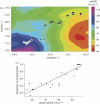Why are not all chilies hot? A trade-off limits pungency
- PMID: 22189403
- PMCID: PMC3311884
- DOI: 10.1098/rspb.2011.2091
Why are not all chilies hot? A trade-off limits pungency
Abstract
Evolutionary biologists increasingly recognize that evolution can be constrained by trade-offs, yet our understanding of how and when such constraints are manifested and whether they restrict adaptive divergence in populations remains limited. Here, we show that spatial heterogeneity in moisture maintains a polymorphism for pungency (heat) among natural populations of wild chilies (Capsicum chacoense) because traits influencing water-use efficiency are functionally integrated with traits controlling pungency (the production of capsaicinoids). Pungent and non-pungent chilies occur along a cline in moisture that spans their native range in Bolivia, and the proportion of pungent plants in populations increases with greater moisture availability. In high moisture environments, pungency is beneficial because capsaicinoids protect the fruit from pathogenic fungi, and is not costly because pungent and non-pungent chilies grown in well-watered conditions produce equal numbers of seeds. In low moisture environments, pungency is less beneficial as the risk of fungal infection is lower, and carries a significant cost because, under drought stress, seed production in pungent chilies is reduced by 50 per cent relative to non-pungent plants grown in identical conditions. This large difference in seed production under water-stressed (WS) conditions explains the existence of populations dominated by non-pungent plants, and appears to result from a genetic correlation between pungency and stomatal density: non-pungent plants, segregating from intra-population crosses, exhibit significantly lower stomatal density (p = 0.003), thereby reducing gas exchange under WS conditions. These results demonstrate the importance of trait integration in constraining adaptive divergence among populations.
Figures



References
-
- Ghalambor C. K., Reznick D. N., Walker J. A. 2004. Constraints on adaptive evolution: the functional trade-off between reproduction and fast-start swimming performance in the Trinidadian guppy (Poecilia reticulata). Am. Nat. 164, 38–5010.1086/421412 (doi:10.1086/421412) - DOI - DOI - PubMed
-
- Conner J. K. 2002. Genetic mechanisms of floral trait correlations in a natural population. Nature 420, 407–41010.1038/nature01105 (doi:10.1038/nature01105) - DOI - DOI - PubMed
-
- Via S., Hawthorne D. J. 2005. Back to the future: genetic correlations, adaptation and speciation. Genetica 123, 147–15610.1007/s10709-004-2731-y (doi:10.1007/s10709-004-2731-y) - DOI - DOI - PubMed
-
- Schluter D. 2009. Evidence for ecological speciation and its alternative. Science 323, 737–74110.1126/science.1160006 (doi:10.1126/science.1160006) - DOI - DOI - PubMed
-
- Miller S. P., Lunzer M., Dean A. M. 2006. Direct demonstration of an adaptive constraint. Science 314, 458–46110.1126/science.1133479 (doi:10.1126/science.1133479) - DOI - DOI - PubMed
Publication types
MeSH terms
Substances
LinkOut - more resources
Full Text Sources

